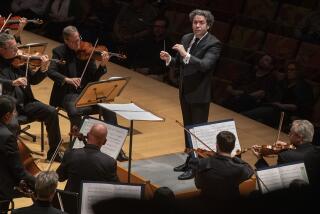Sofia Gubaidulina’s spiritually musical journey
Dressed mundanely in a teal blouse framed by a cream-colored jacket and slacks, Sofia Gubaidulina could be just another diminutive retiree, ready for a game of canasta or a lap around the mall. But in fact this unassuming senior citizen, who remains unknown to most Americans, is among the world’s foremost composers. Her scores have made a deep impression on such prominent musicians as the violinists Gidon Kremer and Anne-Sophie Mutter, and, more recently, on Los Angeles Philharmonic music director Gustavo Dudamel.
Indeed, on Thursday at Walt Disney Concert Hall, Dudamel will give the American premiere of Gubaidulina’s “Glorious Percussion,” a work for orchestra and five percussion soloists whose first performance he led in 2008 with Sweden’s Gothenburg Symphony Orchestra. The piece will be sandwiched between Brahms’s “Tragic” Overture and Symphony No. 2 as part of the philharmonic’s “Brahms Unbound” series on a program to be repeated Saturday and Sunday. The composer, who arrived in Southern California last week, is expected to attend Thursday’s concert.
But the 79-year-old Gubaidulina (pronounced goo-by-DOO-leen-ah) — who first gained fame in the Soviet Union, where she was born — did not leave her home near Hamburg, Germany, solely for that purpose. The initial part of her visit (her first to Southern California) has been spent as an honored guest of Cal Arts, where she has met with faculty and students to discuss her music. A cross section of her prolific output was the focus of a four-concert series that ran through Tuesday at REDCAT, the Cal Arts performance space in the Disney Hall complex downtown.
“It’s such an opportunity to have so many pieces of mine performed by students and professionals here,” Gubaidulina said Thursday between rehearsals at the Cal Arts campus in Valencia, her words translated from Russian. “In meeting the students of Cal Arts, I am meeting the future musicians of 21st century who will perform my music.”
Gubaidulina’s substantial oeuvre — well over a hundred pieces to date — cannot be summed up succinctly, but her music has earned a reputation for earnestness since she first achieved international recognition in the 1980s. Though she is a practicing Orthodox Christian and has written explicitly religious works — her St. John Passion in honor of the new millennium is perhaps the best example — the composer does not credit her faith alone with her interest in the nexus between music and spirituality.
“I feel very strongly that music already has spirituality firmly planted and naturally already,” she said. “Music is the art form that stands closest to the spiritual. It’s as close as we can get to spirituality in art. All music and any music is spiritual, or at least has an element of spirituality.”
Citing “Glorious Percussion” to illustrate her point, she draws parallels between the work’s vibrations and a larger spiritual context. “There is a percussive existence in the heavens as well as on Earth,” she said. “The pulsations exist always, even if we don’t always hear them. That is sometimes revealed with percussion. And the name ‘Glorious Percussion’ implies a connection with the heavens. Though there is nothing confessional or church-related in this piece, it is very spiritual. So the solo percussionists – when they drum this rhythm, this pulse – they create this connection we can’t hear. And yet we ‘hear’ something we can’t hear.”
Hearing Gubaidulina’s first violin concerto, “Offertorium” (1980), written for Kremer, so impressed Mutter that she almost immediately sought her own commission. “She’s such an inventive and pure composer,” Mutter said by phone from Munich last week. “Everything is perfect in its proportion, and in the philosophy behind it. There is a balance between high and low frequencies, and between darkness and light. She wrestles on several different levels with her musical conflicts.”
But while acknowledging the mathematical aspects of Gubaidulina’s scores, Mutter marvels at something more universal. “It’s quite amazing that at the end of all that, her music speaks so perfectly to the heart,” the violinist said. “That’s what makes her music a wonderful bridge between the past and the present. Her music is full of emotional and shattering moments, and that’s something we can all relate to — the drama as well as the serene spots.”
More to Read
The biggest entertainment stories
Get our big stories about Hollywood, film, television, music, arts, culture and more right in your inbox as soon as they publish.
You may occasionally receive promotional content from the Los Angeles Times.






